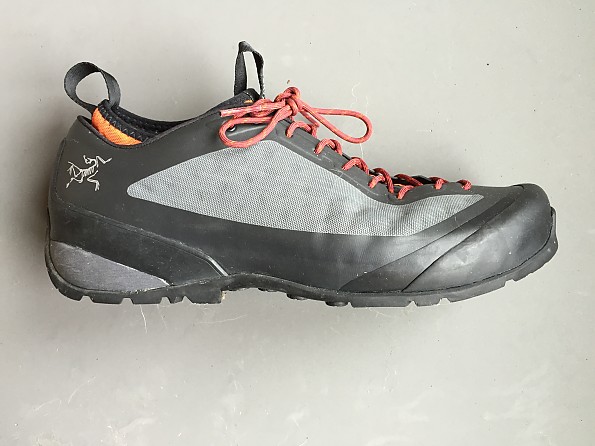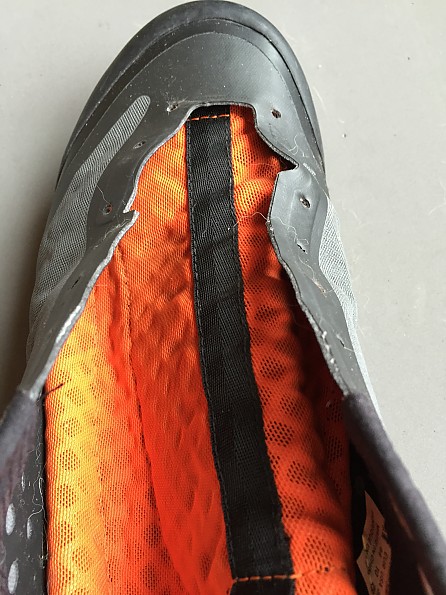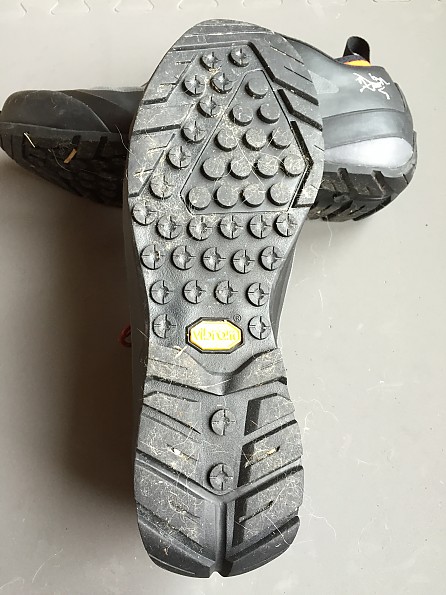Arc'teryx Acrux FL

A very impressive shoe with a design unlike any other shoe I have used previously because of the unique inner and outer construction. I would highly recommend this shoe for anyone looking for a durable, light, and comfortable approach/hiking shoe.
Pros
- Adaptive liner
- Durable outer
- Well constructed
Cons
- Liner is not removable
I had the opportunity to test the Arc'teryx Acrux FL (originally Alpha FL) hiking/approach shoe during the winter of 2014-2015 in the White Mountains region of New Hampshire.
Fit and Comfort:
Over the years I have purchased a variety of footwear. These have ranged from sandals to ski boots, running shoes to heavy weight backpacking boots. The majority of the time I have found that I land comfortably in an off the shelf regular width men's size 10 with the rare 9.5 thrown in to keep things exciting. With that being said, it is always a risk when trying out a new brand to see where their sizing falls into the mix.
When I first took the Acrux FL out of the box I was skeptical that it would fit my foot and be at all comfortable. The inner liner appeared to be too tight and the stiff outer gave me pause since it did not give the impression that it was very flexible.
However, once I put them on my feet the previous concerns were eliminated. I found that the inner liner surrounded my foot in a custom feel almost immediately. While the liner is too snug for a bulky thick sock, my foot fits well while wearing a range of sock thicknesses from light weight summer to mid-weight wool socks. The majority of my usage has been paired with mid-weight wool socks due to the temperatures during the testing period.
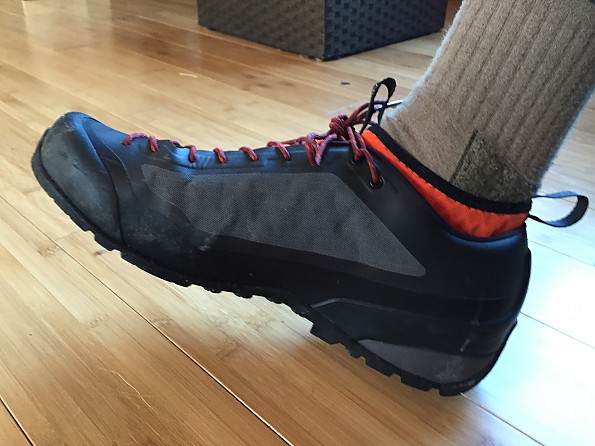
The outer shell proved to be forgiving and easy to break in and I felt comfortable taking them on trips soon after I received them.
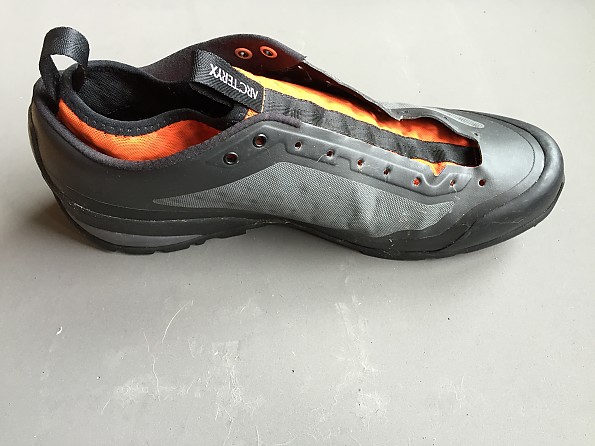
The lacing pattern extends from the toe box to the ankle cuff allowing for many levels of refinement. This lacing pattern gives the Acrux FL more of an approach shoe fit without being too restrictive.
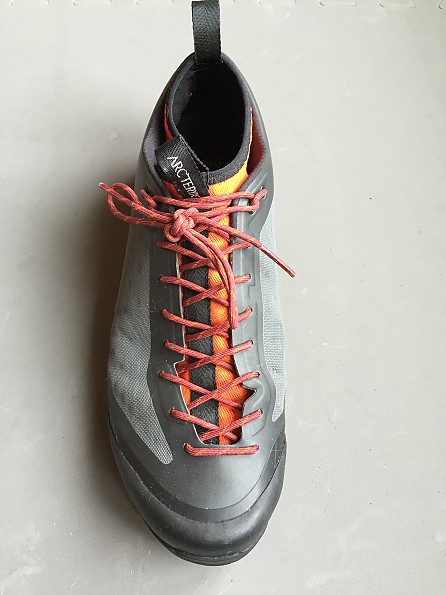
The inner liner is a single piece that does not contain a tongue. This allowed for the cuff to fit snugly around my entire ankle helping keep snow and debris from entering the shoe. Given that this is a low-profile shoe, I would say it performed at expectation in regards to keeping out snow.
The only thing I did not like about the Acrux FL was that the liner was not removable. Based on my research of the other models from this line, it appears that the FL series is the only one with a non-removable liner. Two issues crop up with the fixed liner.
First, is that the shoes require a longer dry time. The second issue is more of a limitation in potential use. Arc'teryx sells a high-cuff liner that fits inside of its other models. With that liner, I would have felt much more comfortable in snowy conditions.
While the liner is not removable, the foot bed insole is removable which allows for the use of orthotic inserts.
Support:
The Acrux FL is a low cut approach/hiking shoe and does not extend above the ankle and therefore does not provide support above the cuff. However, the construction of the out-sole and mid-sole create a very supportive and stable structure which allowed for sure footed strides. The design of the sole also provided cushion with out a feeling of extra padding under the foot.
Water Resistance:
The single piece outer is extremely water resistant and prevents water from entering the shoe. There are various levels of the Acrux FL series and the version I tested did not have the Gore-tex liner. With that being said, the liner on the Acrux FL is fairly water resistant. It kept my feet dry from standing snow and shed light water well. It will be interesting to see how this shoe performs during warmer weather when conditions will lead to more exposure to running and falling water.
Traction:
The out-sole is well designed to handle a variety of terrain and conditions. I felt confident on ice, snow, and dirt. While I was not able to test the traction on rock scrambles due to the conditions during the testing window, I have had approach shoes in the past with similar Vibram sole construction and those have always performed well.
Even though I don't want to see the snow go away just yet I do look forward to hopefully having the opportunity to test the tread pattern on the granite trails of the higher peaks in the Whites this summer.
Temperature Control:
I tested these shoes during the winter in New England and found that when paired with a mid-weight wool sock my feet stayed warm and dry. I would not advise using these for long extended outings during cold weather since I feel that that would be beyond the bounds of these shoes. However, they perform well day-after-day for shorter outings in colder temperatures above 20 degrees.
One question that remains is how well this shoe will wick sweat from my feet during the warmer summer months. If I am able to continue testing I will provide an update.
Features:
There are two features which set this shoe apart from any other approach/hiking shoe I have worn. First, is the inner liner, and second is the outer shell.
Arc'teryx claims the inner liner has an “Adaptive Fit” and I found this claim to be accurate. The stretch material used in the liner's construction wrapped perfectly around my foot and with no seams, I had no areas that created pressure or discomfort.
The upper is what really impressed me about this shoe. As I mentioned previously, I was skeptical of how well the upper would break in. Out of the box it is stiff and uncomfortable looking. However, once the shoe is on and moving, the upper proves to be supple and conforming. I was able to review some materials provided by Arc'teryx which describe the construction as a polyurethane coated nylon textile which is woven, layered, and heat set to create a smooth single piece construction that does not contain seams. The outer shell stands up well against ice and snow as well as dirt, salt, and water.
Construction & Durability:
Arc'teryx did a wonderful job constructing this shoe. The outer shell is extremely durable and has held up well over the testing period. I am looking forward to seeing how they perform against the granite trails this summer, but from what I have seen so far I am fairly confident they will work well.
The inner liner has also held up well over use. The stitching is well intact and I have not noticed any internal wear in the foot bed. This is going to be an area I pay close attention to over time as my feet have a tendency to be rough on shoes and I find that the areas under the ball of my foot and my heel become worn quicker than the rest of the shoe.
Conditions:
I tested this shoe during the winter of 2014-2015 in the White Mountains of New Hampshire. One may not feel that a low cut approach shoe would be adequate during this time period, but I found that the Acrux FL performed above expectation.
Paired with a mid-weight wool sock I felt comfortable taking this shoe out on hiking and snowshoeing trips in temperatures down to around 20 degrees on trails with between 6 and 10 inches of fresh snow.
Because the shoe has a low-cut profile, I found that it was best to wear a gaiter if I was going to encounter snow. This was simply a way of adding an extra layer of protection from snow building up around my ankles.
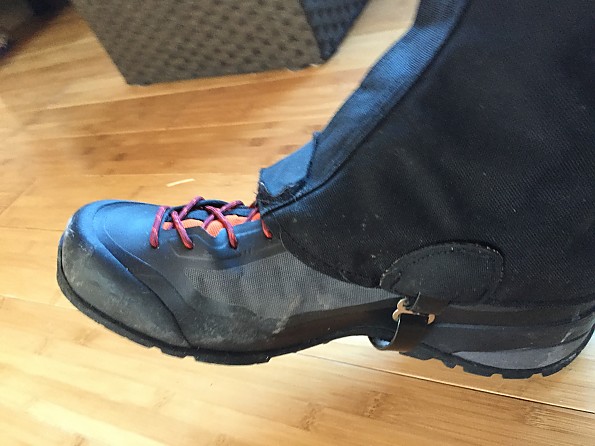
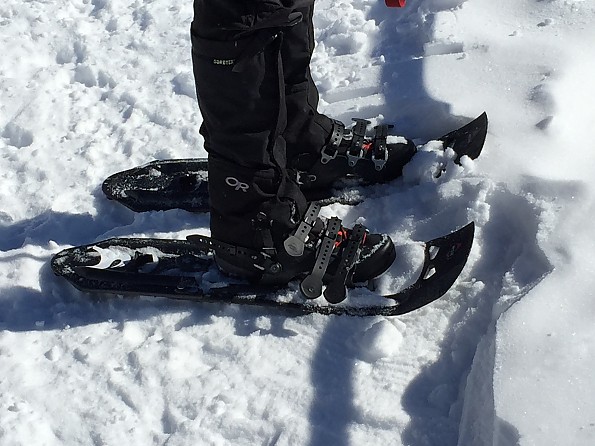
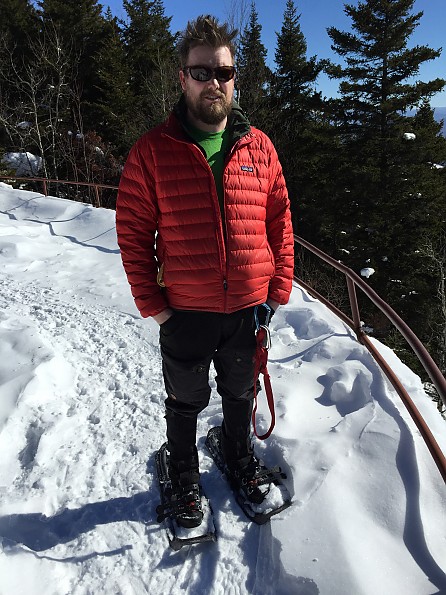
The outer shell held up well against snowshoes and did not show any signs of wear and tear.
Overall Summary:
I was very impressed by the Acrux FL shoe by Arc'teryx. The design is unlike any shoe I have used previously and I found it to be well thought out, designed, and constructed. The Acrux FL exceeded my expectations by holding up well against the New England winter conditions.
I would highly recommend this shoe for anyone looking for a durable, light, and comfortable approach/hiking shoe.
Source: received for testing via the Trailspace Review Corps
(Sample provided by Arc'teryx for testing and review)
Like the engineering ideas, flaws in liner design.
Pros
- Great concept
- Comfortable
- Lightweight
- Breathable
Cons
- Liner rubbed both my heels bloody within 3 miles
As a big fan of Arc'teryx products I was excited to see how they would reinvent the approach shoe. I liked the weight, the seamless body, the airflow, they were very comfortable. BUT, the first short hike of about three miles with no-show socks revealed that the non removable liner keeps moving around in the heel area, cutting through the skin of both my heels until blistering and bleeding.
Can't return since they have been worn and the blistering is (according to Arc'teryx rep) not a reason to send them back for a refund. I never had an issue with any shoe before. My feet are not overly sensitive. In my opinion these shoes are problematic if worn without protective socks between the liner and the skin.
There is a good reason that most manufacturers put a lot of thought into a non-abrasive heel design.
In my case a complete letdown.
Source: bought it new
Price Paid: $190
Your Review
Where to Buy
You May Like
Best for: approaches and day hikes on technical terrain
Specs
| Men's | |
|---|---|
| Price |
MSRP: $190.00 Historic Range: $119.99-$200.00 Reviewers Paid: $190.00 |
| Weight |
410 g (8.5 UK) |
| Women's | |
|---|---|
| Price |
Historic Range: $39.00-$200.00 |


